Masjidul Aqsa

Al Aqsa Mosque, Palestine
The Al Aqsa Mosque is the third holiest lace for Muslims- Mecca and Medina being the first two. The mosque is the central place for the Muslim population in Jerusalem and has an history of being the Royal Palace for Crusaders and the headquarters for the Kings of Templar.
The beautiful mosque has seen many earthquakes and a few destructions as well. However, today the mosque stands tall on the Temple Mount and is a fabulous collection of art- including Romanesque style facades, Carrara Marble structures and intricately painted ceilings.





Western Wall

DOME OF ROCK
Mosques in Jerusalem
By the Editors of the Madain Project
This page attempts to enlist all the known mosques in the city of Jerusalem
Contents Hide/Show
- List of the Mosques
- al-Buraq Mosque
- Umar Mosque
- al-Aqsa Mosque
- Masjid al-Marwani
- Mosque of Umar
- Khanqah Salahiyya Mosque
- Sheikh Jarrah Mosque
- Masjid Qala
- Masjid Maghraba
- Sheikh LouLou Mosque
- al-Dissi Masjid
- al-Maulawiya Mosque
- Ascension Mosque
- Masjid Okasha
- Red Minaret Mosque
- Masjid Afghani
- Busairi Mosque
- Mathana mosque
- al-Qalawun Mosque
- Hejazi mosque
- Masoudi Mosque
- Abdeen mosque
- Haret el-Nasari Mosque
- Haret el-Arman mosque
- Mosque of al-Elmi
- al-Karemi mosque
- al-Qormee Mosque
- Yaqoubiyya Masjid
- Khaldeya mosque
- Mosque of Al-Hanablah
- Mosque of Al-Tur
- Masjid Suekat Uloon
- Masjid al-Sheikh Makki
- Mosque of Rabia al-Adaweya
- Masjid Uthman ibn Affan
- Masjid Sayedna Umar
- Mosque of Suleyman al-Farsi
- Mosque of Khan Al-Zeit
- Mosque of Dar al-Imam
- Mosque of Bab Al-Ghawanima
- Masjid Kursi Suleiman
- Mosque of Bab Hattah
- Mosque of the Dome of Moses
- Mosque of David the Prophet
- Shurbaji Mosque
- Masjid Abu Bakr Siddique
- Adhami Masjid
- Masjid Ras al-‘Amud
- See Also
- References
See Subject Home > Middle East > Israel/Palestine > Jerusalem > Mosques
https://platform.twitter.com/widgets/tweet_button.d37472b4a6622d0b1fff46ad904f6896.en.html#dnt=false&id=twitter-widget-0&lang=en&original_referer=https%3A%2F%2Fmadainproject.com%2Fmosques_in_jerusalem&size=m&text=Mosques%20in%20Jerusalem%20-%20Madain%20Project%20(en)&time=1697804904628&type=share&url=https%3A%2F%2Fmadainproject.com%2Fmosques_in_jerusalem&via=MadainProject
List of the Mosques
circa 690 CE
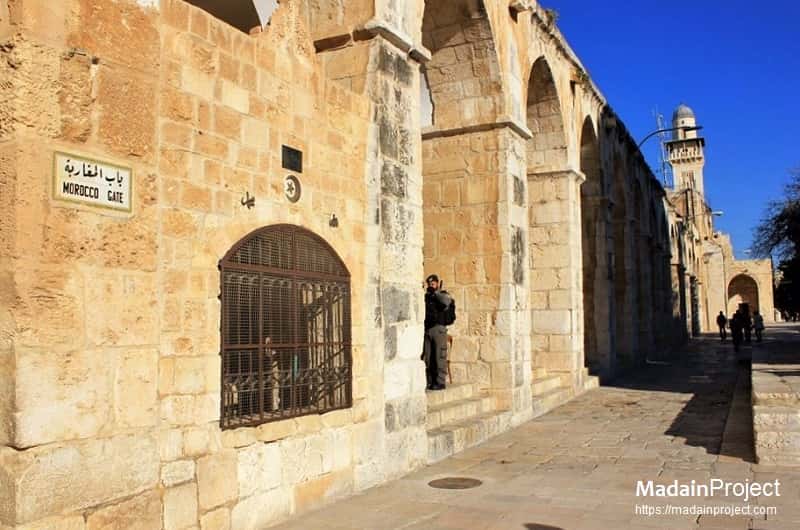
al-Buraq Mosque
The al-Buraq Mosque (مسجد البراق), located at the western flank of the Temple Mount (Haram al-Sharif) beside the Morocco Gate. The mosque (windowed structure to the left) is located north of the Bab al-Magharibah. The chain gate minaret is also visible to the right in the background. al-Buraq Mosque is a subterranean barrel vault built next to al-Buraq Wall (Western Wall). The mosque is still open for prayers as worshipers use this entrance located in al-Aqsa’s western corridor.
circa 640 CE
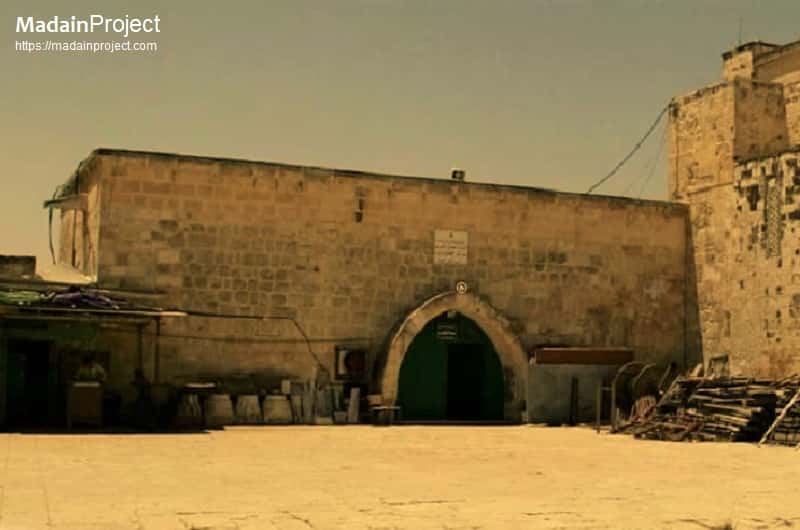
Umar Mosque
The Umar Mosque, also spelled as Masjid al-Omer (مسجد عمر), inside the Haram al-Sharif. This is the original purported location where according to tradition Omar ibn al-Khattab offered Salah when he arrived in the city after it surrendered to Muslim forces in 640 CE. Today it is used as a wherehouse for the al-Aqsa management and administration.
circa 690 CE
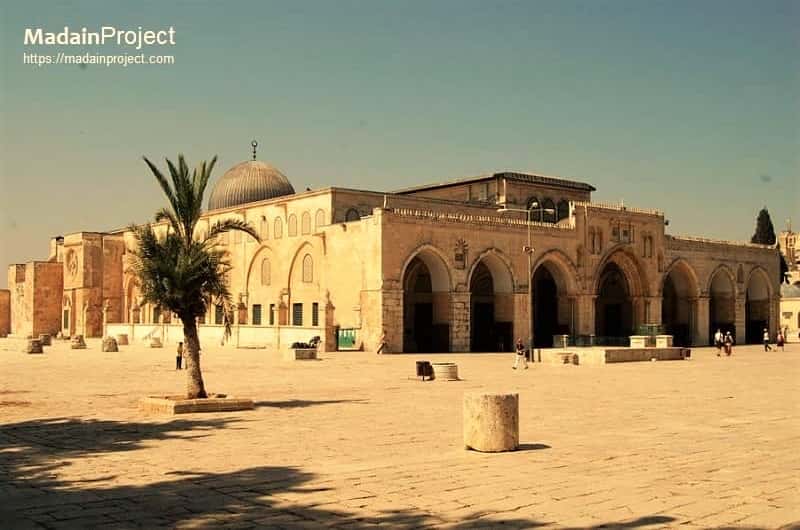
al-Aqsa Mosque
al-Aqsa Mosque (المسجد الأقصى), the mosque was originally a small prayer house built by the Rashidun caliph Umar, but was rebuilt and expanded by the Umayyad caliph Abd al-Malik and finished by his son al-Walid in 705 CE. It was first built 40 years after al-Masjid al-Haram in Mecca. The current construction of the al-Aqsa Mosque is dated to the early Umayyad period of rule in Palestine. According to several Muslim scholars, including Mujir ad-Din, al-Suyuti, and al-Muqaddasi, the mosque was reconstructed and expanded by the caliph Abd al-Malik in 690 along with the Dome of the Rock.
circa 690 CE
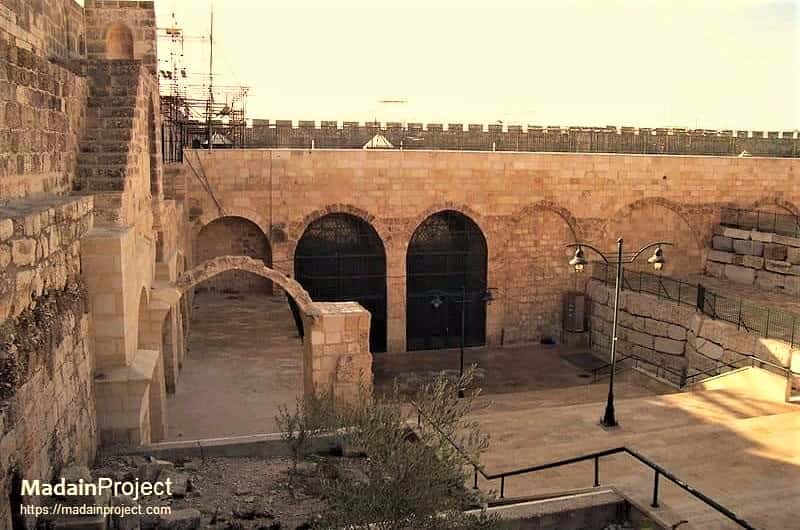
Masjid al-Marwani
Masjid al-Marwan (مسجد المرواني), also known as he Mussala al-Marwani, and Solomon’s Stables, modern entrance to the structure, from within the Haram al-Sharif as seen from the Temple Mount platform close to the eastern wall. It is a massive subterranean hall located in the south-eastern corner of the al Aqsa mosque. It extends over four and a half acres of land and can cater for approximately 6000 worshippers at once. In December 1996 the new mosque was officially inaugurated as el-Marwani Mosque.
circa 1193 CE
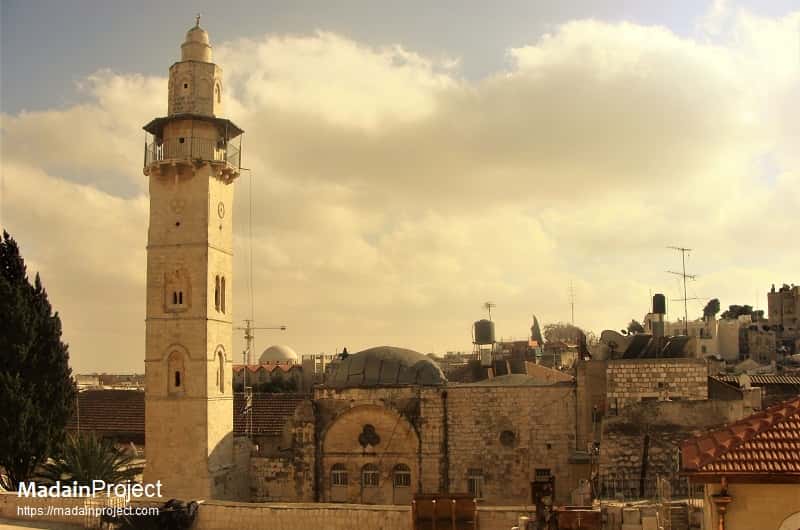
Mosque of Umar
Mosque of Omar (مسجد عمر بن الخطاب), next to the Church of Holy Sepulchre, in the walled city of Jerusalem. Originally built as a small wooden structure in front of the Holy Sepulcher in circa 1180 CE, it was renovated several times over the centuries, current bulding dates back to the middle of nineteenth century. The current Mosque of Omar was built in its current shape by the Ayyubid Sultan Al-Afdal ibn Salah ad-Din in 1193 to commemorate the prayer of the caliph Omar. The minaret of the Masjid Umar is identical to the minaret of Khanqah al-Salahiyya.
circa 1193 CE
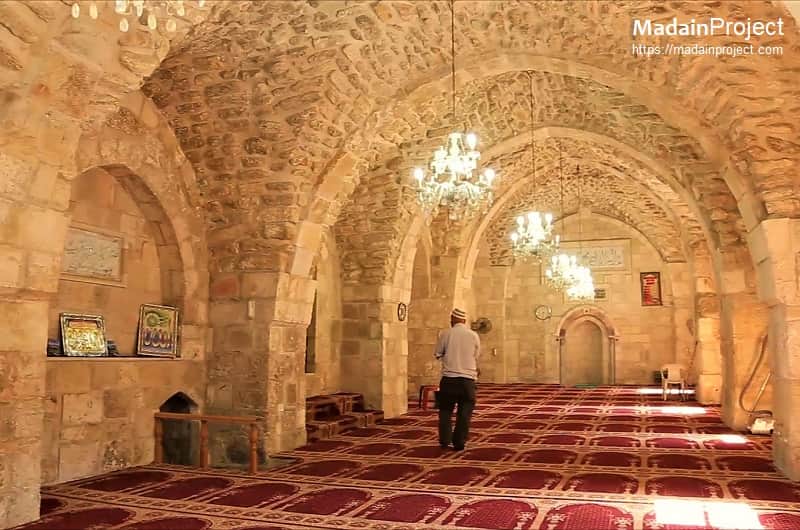
Khanqah Salahiyya Mosque
The main prayer hall of the of al-Khanqah al-Salahiyya Mosque (مسجد الخانقاه الصلاحية). This mosque was the only place in Jerusalem where a Palestinian flag could be seen, it was removed in 2009. Commissioned by Salah ul-Din Ayyubi in 1189 CE. It is also known as the Khilwah (retreat) of Salah al-Din Ayyubi. The Mosque of Omar, located on the other side of the Church of the Holy Sepulchre, has an almost identical minaret.
circa 1200 CE
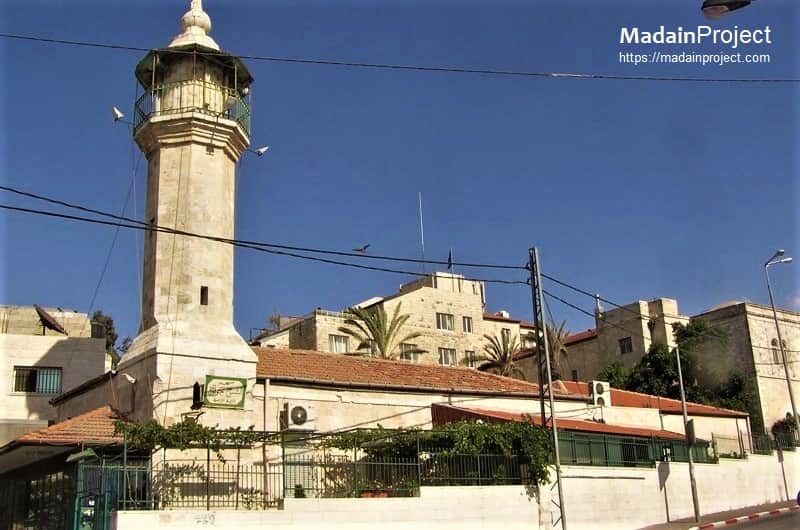
Sheikh Jarrah Mosque
Sheikh Jarrah Mosque (مسجد الشيخ جراح), established by Hussam al-Din al-Jarrahi as a Zawiya, the Zawiya al-Jarrahiyya, a small educational institution for children. After death he was buried on the school grounds, in 1201 a tomb was built for him. This mosque is attributed to a famous leader in the saladin army called al-Hussein Bin Issa al-Jarrah. When he died in 598 Hj., he was buried on the south side of nablus road, and a room was built over his grave.
circa 1213 CE
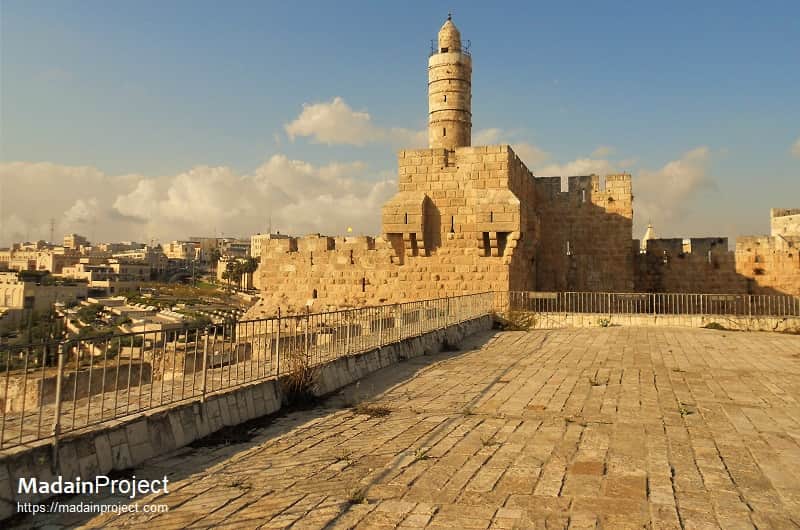
Masjid Qala
Originally established during the Memluk era and renovated during Ottoman era the interior of al-Qala’a Mosque (مسجد القلعة) is very simple. It served the Muslim soldiers during the Jordanian Ottoman rule as well. Its name was given it because of its place in the Tower, ‘Qalaah’ (Arabic). The mosque is in the southern part of the Citadel’s eastern barbican. The ditch of the Jerusalem Citadel, along with the battlements placed above its glacis, border this mosque from east, west, and south.
circa 1220 CE
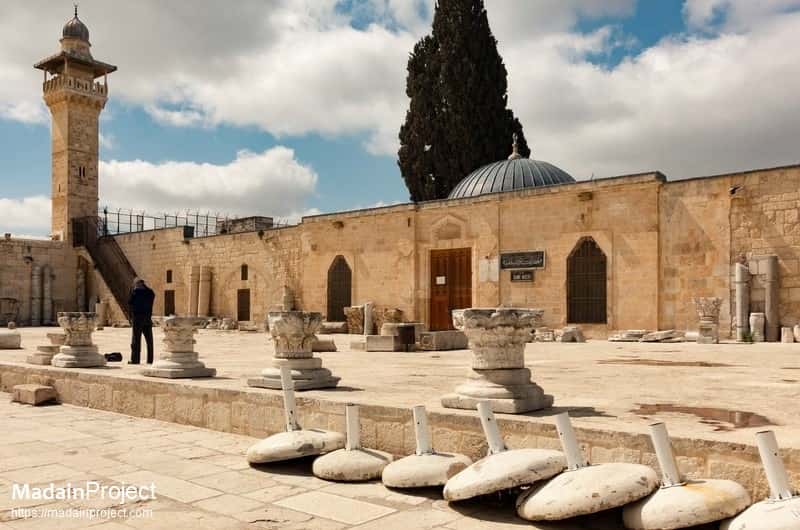
Masjid Maghraba
Magharba Mosque (مسجد المغربه), now the Islamic Museum, is situated inside the Moroccans’ Gate at Haram al-Sharif It was recently converted into a in the recent years and no longer functions as a mosque. Now it houses exhibits from different Muslim eras. The building was originally constructed by the Knights Templar, who used it as an annex to their headquarters established at the former al-Aqsa Mosque. Following the Muslim reconquest of Jerusalem, the mosque was restored in 1194 CE.
circa 1400 CE
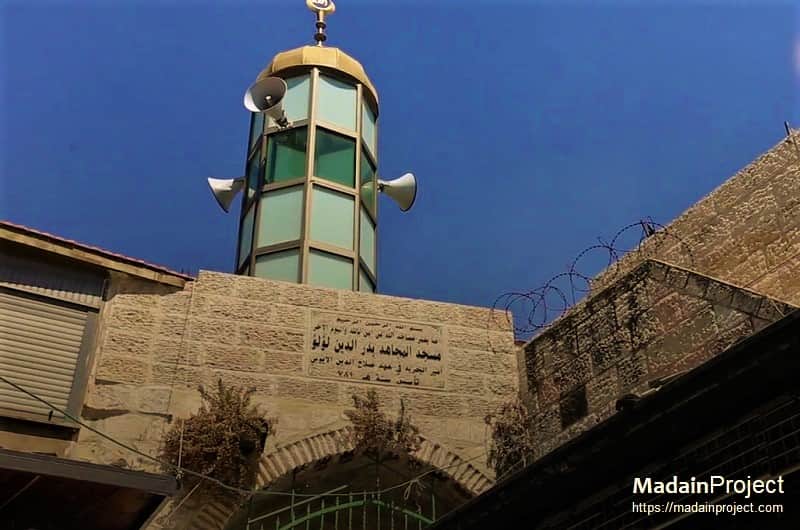
Sheikh LouLou Mosque
The main entrance to the Sheikh Loulou Mosque (مسجد الشيخ لولو), Emir (Sultan) Bader al-Din Lulu is located on the Sheikh Loulou street in the north-western part of the walled city of Jerusalem.
circa 1487 CE
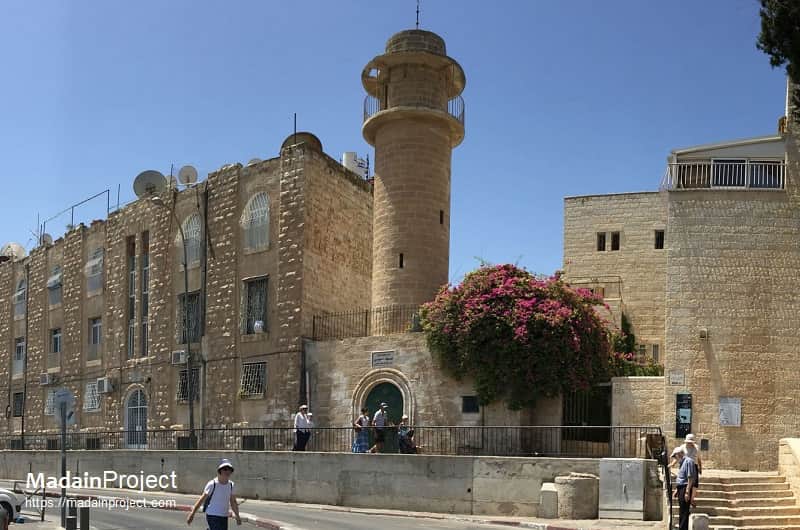
al-Dissi Masjid
al-Dissi Mosque (مسجد الديسي), located in the Armernian Quarter, overlooking the former Moroccan Quarter which was demolished by the Israeli occupation forces in 1967 CE. Endowment documents from late 15th century mention the mosque as “Masjid al-Omar” and property was endowed to be used as mosque by Al-Kameli bin Abu Sharif. Mosque covers an area of 60 square meters and the minaret’s height is 15 meters, it was renovated by the Islamic Waqf.
circa 1200 CE
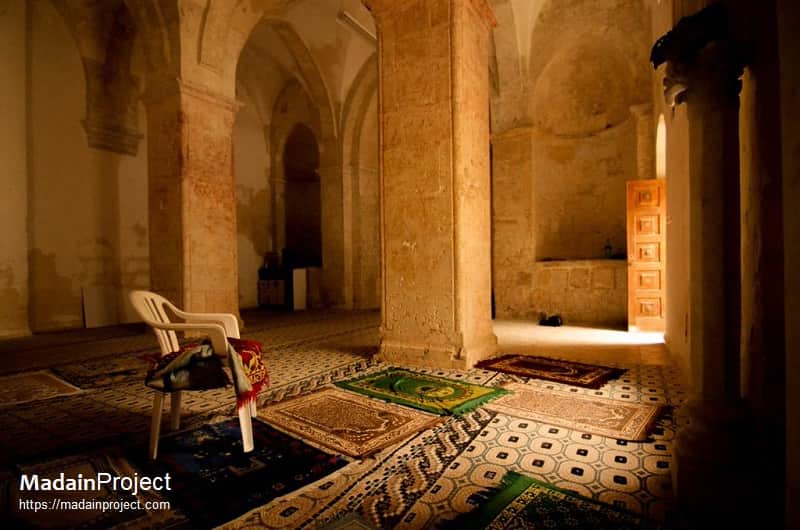
al-Maulawiya Mosque
al-Maulawiya Mosque (مسجد المولوية), located on the highest point in the old city, is an older mosque transformed by the Crusaders into the Church of St Agnes and turned back into a mosque after their defeat. The only visible feature of the mosque is its Ottoman era minaret, from the Jerusalem rooftops.
circa 1200 CE
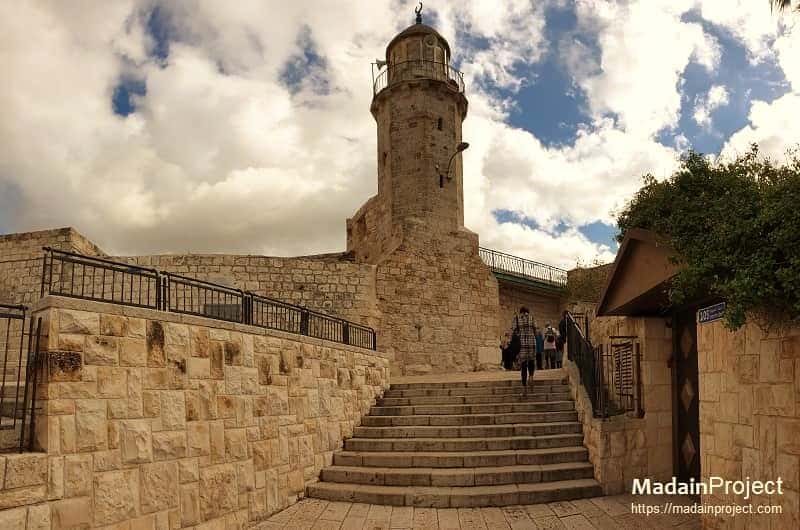
Ascension Mosque
Mosque of Ascension at the Mount of Olives. The mosque was built adjacent to the Chapel of Ascension during Ottoman era. According to the Christian tradition it is located on a site, traditionally believed to be the earthly spot where Jesus ascended into Heaven after his resurrection. After the 1187 conquest, Salah ad-Din established the Mount of Olives as a waqf entrusted to two sheikhs, al-Salih Wali al-Din and Abu Hasan al-Hakari. The ocatagonal parameter wall belongs to the Saladin era.
circa 1850 CE
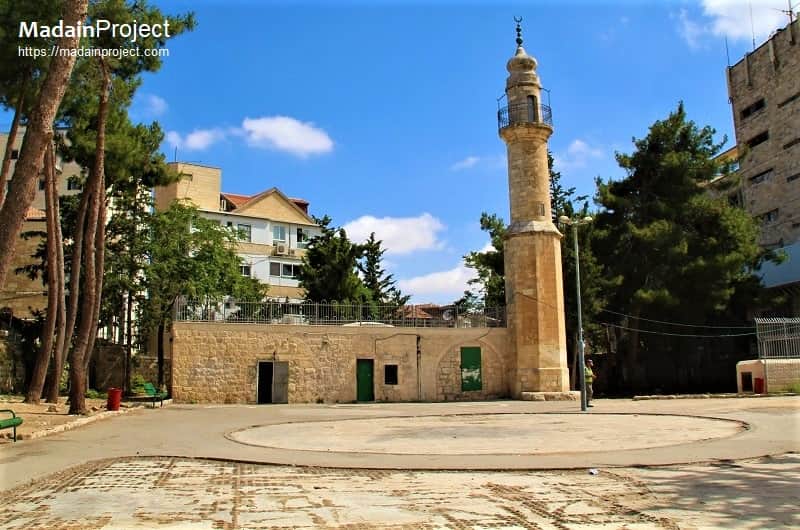
Masjid Okasha
Mosque of Okasha (مسجد عكاشة), also known as the Nebi Akasha Mosque, is a historic mosque located in western Jerusalem. The mosque was built in the 19th century beside the 12th-century tomb of Nebi Ukasha ibn al-Mihsan, one of the disciples of the Prophet Muhammad. According to Islamic tradition, some of Saladin’s soldiers were buried at the site. Later on additions were made to the tomb by the Mamluks in the the 13th-century. The mosque is inactive and the Jerusalem Municipality uses it as a warehouse.
circa 1850 CE
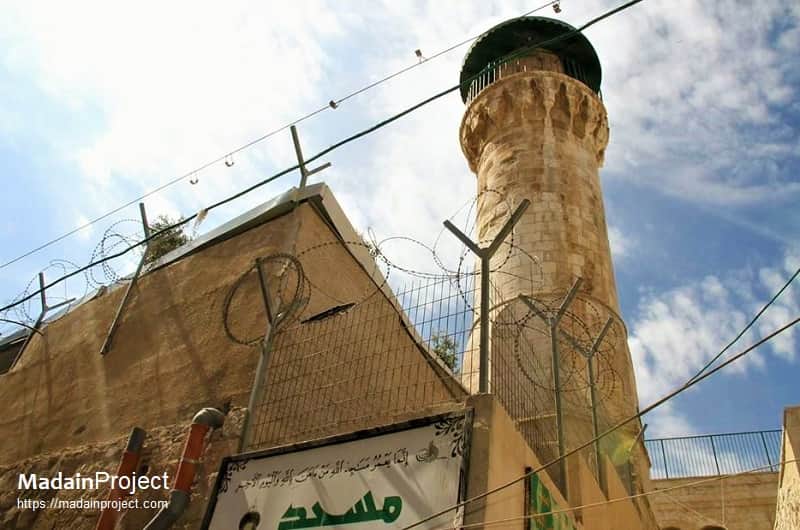
Red Minaret Mosque
Mosque with Red Minaret (مسجد المئذنة الحمراء) is located on Hazariyah Ha’adom Street. It is an ancient mosque dating back to the Ottoman era, located in the Muslim Quarter of old city, it was established in 1533 CE. Originally it was known as the “Masjid Sheikh Ali al-Khalouti“, now it is known as the Masjid Madhna al-Hamra after the red ribbon around the top of the minaret.
circa 1043 CE

Masjid Afghani
Afghani Mosque also Zawiyat al-Afghani (زاوية الأفغاني), originally built in 1043 CE, Zawiyat al-Afghani is a Waqf (trust) situated in Muslim Quarter of the Old city of Jerusalem in Sultan Barkuka street. A small complex which houses a mosque and a hostel built for dervish pilgrims from Afghanistan. To this day Sufi ceremonies are carried out in it. Bar Cook St.
circa 1268 CE
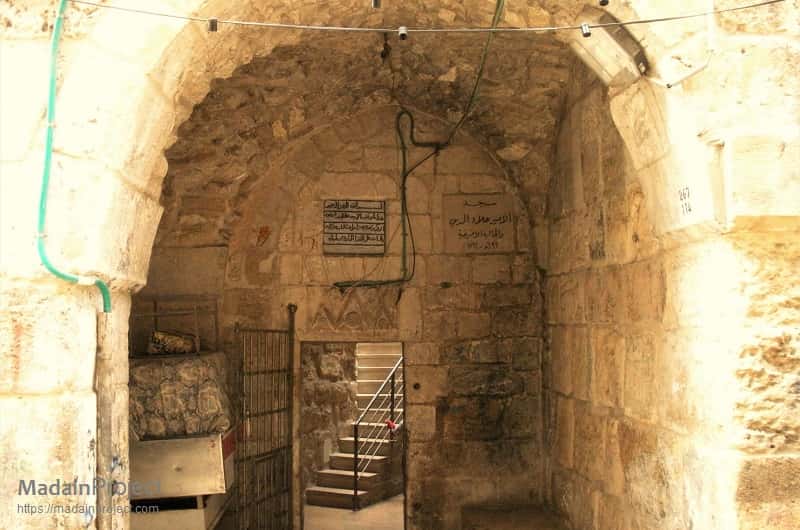
Busairi Mosque
The Aladdin Al-Busairi Mosque (مسجد علاء الدين البصيري) is an ancient mosque dating back to the Mamluk period in Palestine. It is located inside the walls of the Old City of Jerusalem. It is nine meters long and eight meters wide, and next to it is the shrine of Aladdin Al-Busairi, one of the Mamluk princes. A number of poor mistics live in this Ribat, and it was restored it in 1971 after it was previously used as a prison.
circa
Mathana mosque
circa
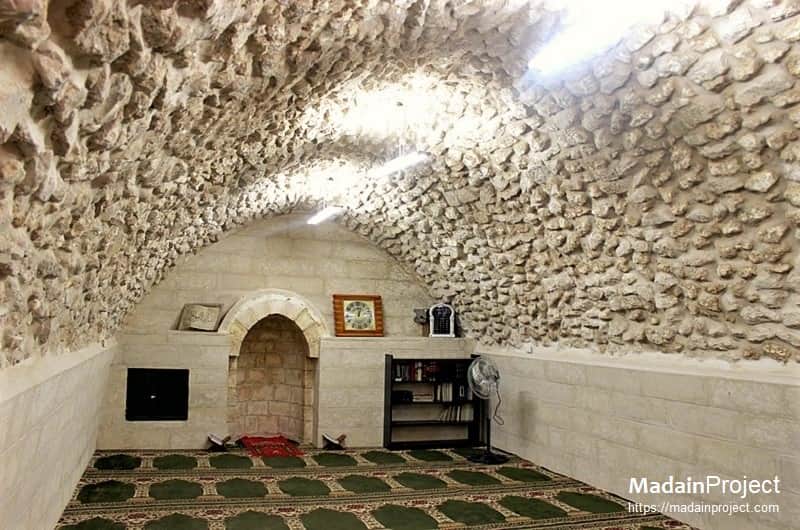
al-Qalawun Mosque
Masjid Qalawun is an ancient mosque in the old city of Jerusalem, dating back to the Memluk era in Palestine, 1288 CE (686 Hj.). It is located inside the walled city near the New Gate. It is a small mosque, measuring only some forty square meters. It is named after the Memluk Sultan al-Mansur al-Qalawun.
circa
Hejazi mosque
(مسجد الحجازي)
circa
Masoudi Mosque
(مسجد المسعودي)
circa 1939 CE
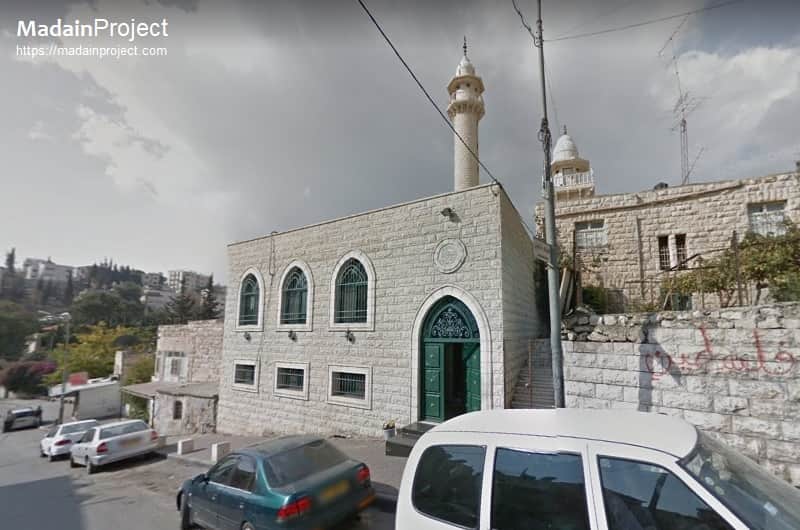
Abdeen mosque
(مسجد عابدين) is situated in Wadi al-Joz, east Jerusalem
circa
Haret el-Nasari Mosque
circa
Haret el-Arman mosque
circa
Mosque of al-Elmi
circa
al-Karemi mosque
circa
al-Qormee Mosque
circa
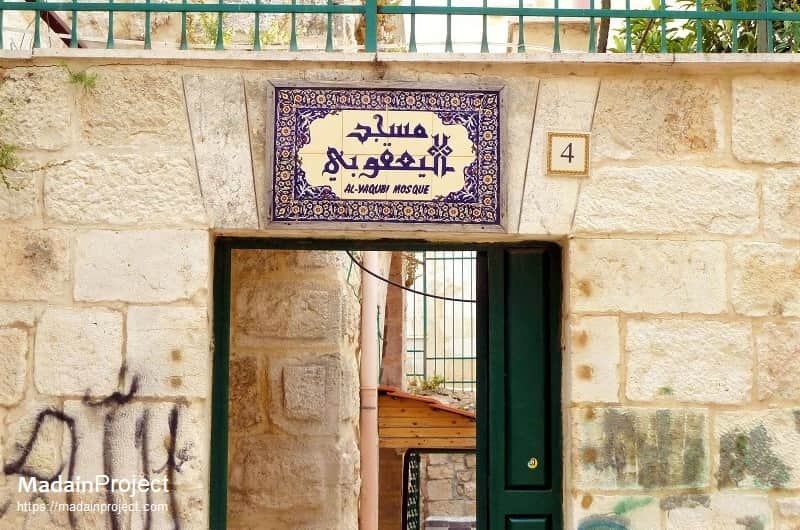
Yaqoubiyya Masjid
The sign above the entrance to the Yacoubiya mosque (مسجد يعقوبي). Located in a Crusader building dating from the 12th cen CE. Named after Jacob, the Christian Saint executed and dismembered in Persia in 342 CE. It was probably converted in to a mosque after the conquest of Jerusalem by Muslim in 1187 CE.
circa
Khaldeya mosque
circa
Mosque of Al-Hanablah
circa
Mosque of Al-Tur
circa
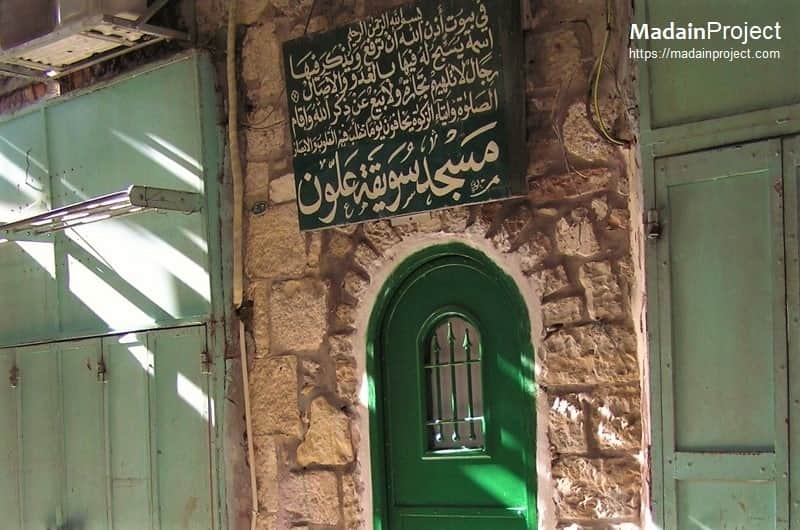
Masjid Suekat Uloon
Masjid Sueka A’alun (مسجد سُويقة علون) or Swaikit ‘Allun Mosque is located within the city wall in the Swaikit ‘Allun market, which extends from Bab al-Khalid (Jaffa Gate) to the intersection of al-Bazar Market and the Christian Quarter. It dates back to the ottoman period.
circa
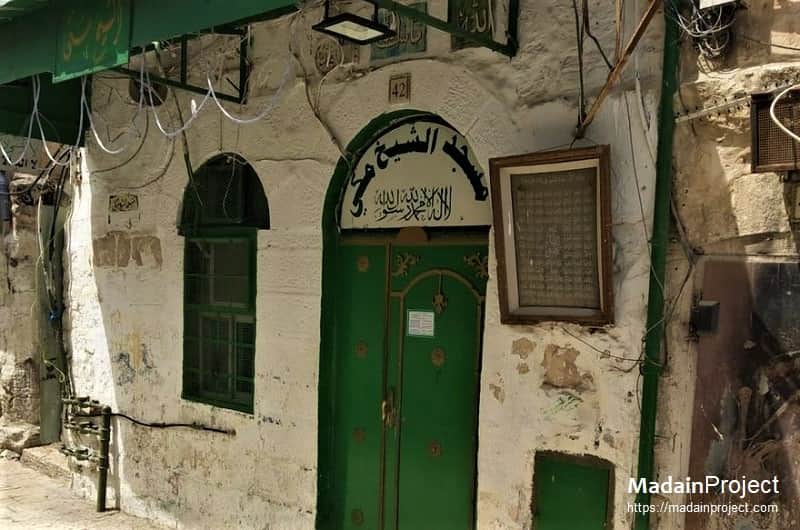
Masjid al-Sheikh Makki
circa

Mosque of Rabia al-Adaweya
circa

Masjid Uthman ibn Affan
Mosque Uthman ibn Affan, also known as the Bazar mosque, the third caliph of Rashidun Caliphate, it is situated in the Street of the Butchers.
circa
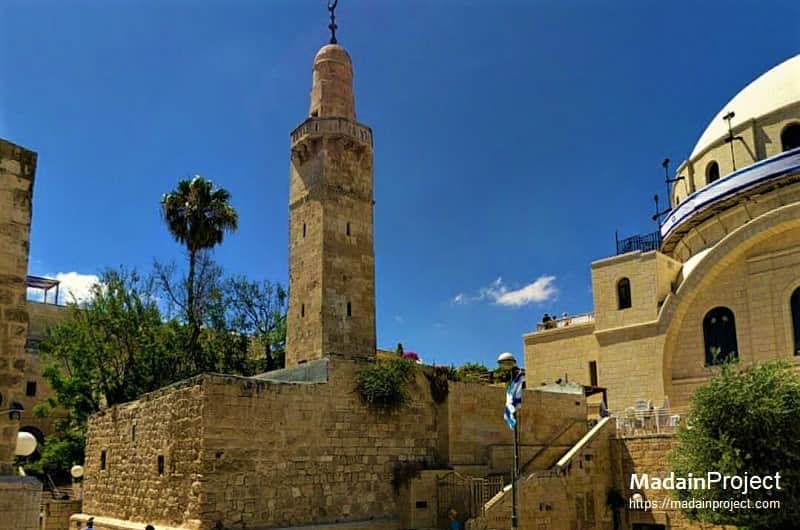
Masjid Sayedna Umar
Masjid Sidna Omar is located next to the Ramban and Hurva synagogues in the Jewish quarter. According to Obadiah ben Abraham Bartenura the mosque was built by Jews who converted to Islam in the first half of the 15th century CE.
circa
Mosque of Suleyman al-Farsi
circa
Mosque of Khan Al-Zeit
circa
Mosque of Dar al-Imam
It is located within the north wall of Haram al-Sharif (Temple Mount) near Bab e Attim.
circa
Mosque of Bab Al-Ghawanima
circa
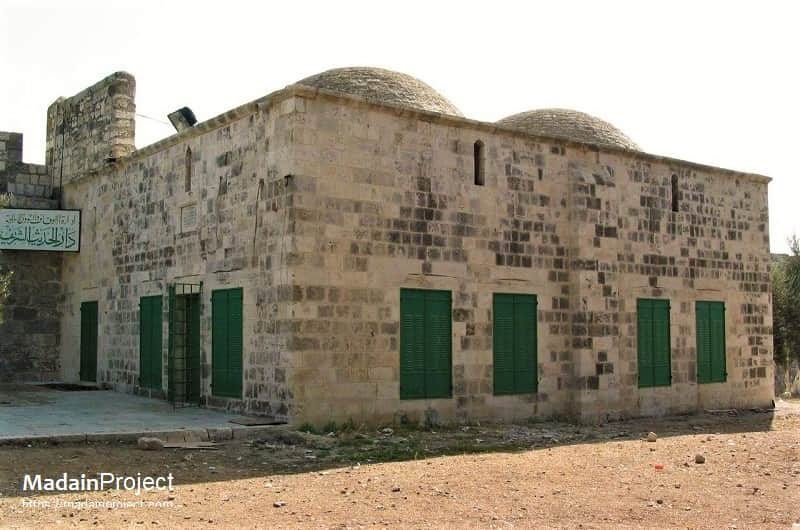
Masjid Kursi Suleiman
Mosque of Suleyman’s throne is most commonly known as the Tomb of Solomon or the Kursi Suleyman, is situated along the eastern wall of Haram al-Sharif. It is also known as the Kursi-i Suleiman (the chair of Solomon) or the foot-stool of Solomon. The building has a large hall divided into different areas, one of which is the prayer area with a mihrab. It is surmounted by two shallow domes. The hall also includes a symbolic tomb which might allude to the tomb of Suleyman or his throne.
circa
Mosque of Bab Hattah
circa
Mosque of the Dome of Moses
circa

Mosque of David the Prophet
It is located in the King David tomb complex.
circa 1685 CE
(1097 Hj.)
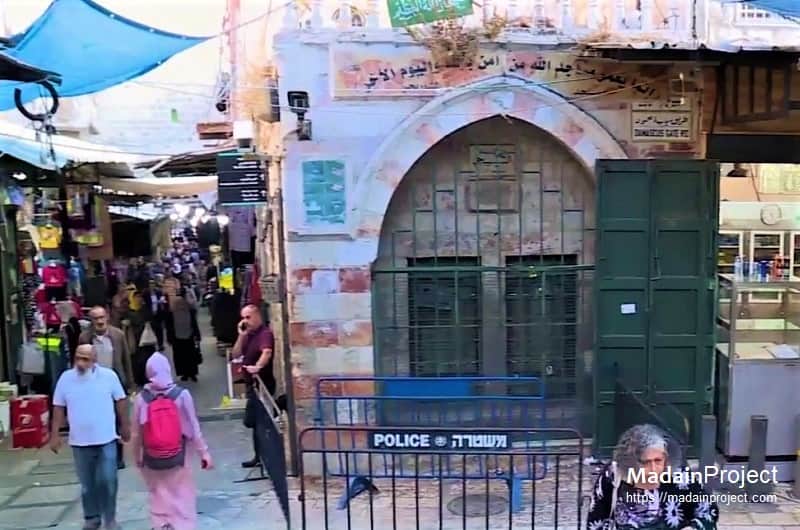
Shurbaji Mosque
Shorbaje mosque (سبيل و مسجد الشوربجي) is situated on the Damascus Road and can be accessed by entering the Old City to the junction of Khan al- Zait, al-Jabsheh, Harat al-Sa’diya, and al-Wad streets. According to the signage above the mosque’s façade, the place was founded in 1097 Hj., that is, in 1685, at the end of the 17th century during Ottoman rule. The Sebil-Mosque is named after Abdul-Karim al-Shurbaji, who lived in Jerusalem in eleventh century.
circa
/01.jpg)
Masjid Abu Bakr Siddique
Masjid e abu Bakr al-Siddique, located some 800 meters from Masjid e Aqsa inside the old city. The mosque is believed to have been rebuilt over remains of an older mosque. The ground level of the structure consists of shops to for upkeep of the mosque while the top level is used for prayers. The mosque used to have one minaret that was demolise in 1967 CE.
circa
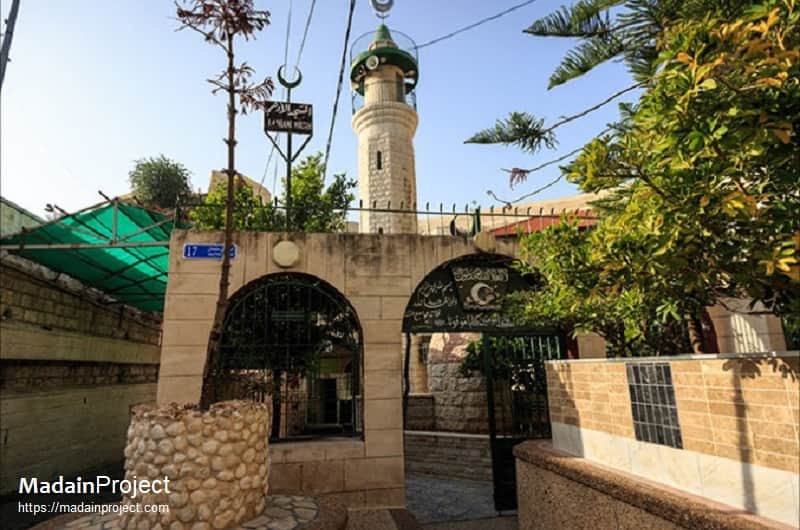
Adhami Masjid
Built in the sixties, al Adhami Mosque (مسجد الادهمي), is located outside the wall of Jerusalem in the Al-Sahira neighborhood, one of the gates of the main wall of Jerusalem, near the old central bus station. The mosque was formerly a room belonging to Al-Badiri, measuring only 8 meters in width and 10 meters in length.
circa 1187 CE
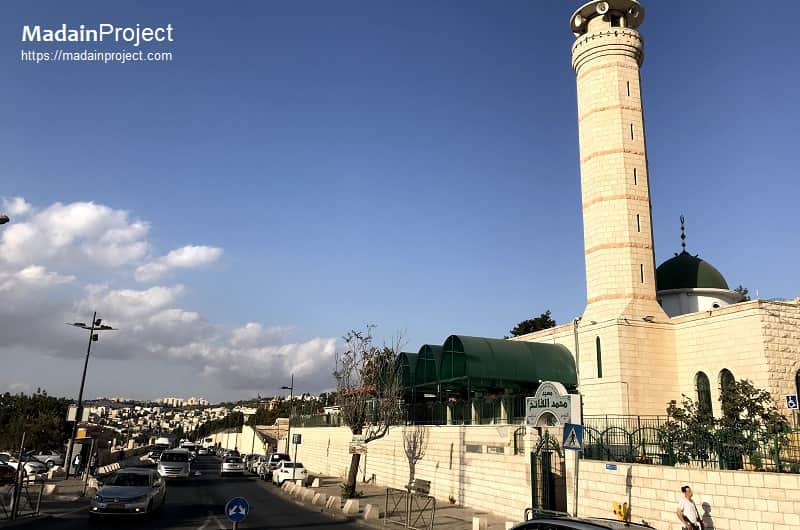
Masjid Ras al-‘Amud
Masjid Ras al-‘Amud (مسجد رأس العامود), in Arabic meaning ‘the head of the column’, also known as the Muhammad al-Fateh Mosque (مسجد محمد الفاتح), is located in the heart of the Ras al-Amud neighborhood, east of the Old City of Jerusalem, on the main historic road that connects Jerusalem and Jericho. The mosque is adjacent to the Jewish Cemetery, at the foot of Mount of Olives. The Ras al-‘Amoud mosque serves the people of Silwan and some of the surrounding neighborhoods.
See Also
References
- Jerusalem: Points Beyond Friction, and Beyond, ed. Moshe Maʻoz, Sari Nusseibeh
- Mosques of Beit Al-Maqdis (مساجد بيت المقدس), Mohammed Al-Kafrawi, Arab Alumni Club, Jerusalem, 1983.
- Elad, Amikam. (1995). Medieval Jerusalem and Islamic Worship Holy Places, Ceremonies, Pilgrimage BRILL, pp. 29–43. ISBN 90-04-10010-5.
- le Strange, Guy. (1890). Palestine under the Moslems, pp. 80–98.
- The Archaeology of the Holy Land: From the Destruction of Solomon’s Temple to the Muslim Conquest, Cambridge University Press, Jodi Magness, page 355
- Winter, Dave & Matthews, John. Israel Handbook, p. 147. Footprint Travel Guides, 1999. ISBN 1-900949-48-2
- Moudjir ed-dyn, 1876, p. 169
- Pringle, Denys (2007). The Churches of the Crusader Kingdom of Jerusalem: The city of Jerusalem. III. New York, NY: Cambridge University Press. ISBN 978-0-521-39038-5.
- Gilad, Moshe (29 August 2012). “Peeking Through the Highrises: Famed Jerusalem street’s old architectural glories”. Haaretz. Retrieved 21 November 2012.
